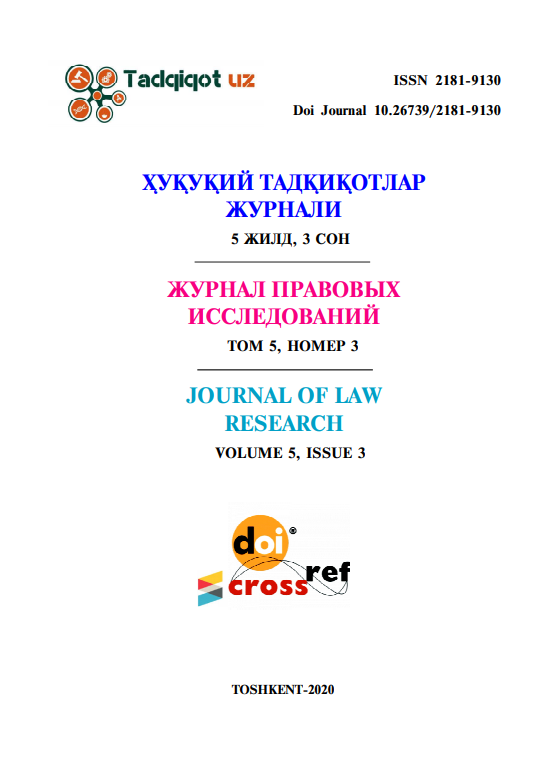ПРЕПЯТСТВИЯ ДЛЯ РАССЛЕДОВАНИЯ КИБЕРПРЕСТУПЛЕНИЙ: СРАВНЕНИЕ НЕКОТОРЫХ СТРАН ОБЩЕЙ ПРАВОВОЙ СИСТЕМЫ И УЗБЕКИСТАНА
Ключевые слова:
правоохранительные органы, кибер, данные, облако, электронная информация, доказательства, эксперт, криминалистика, интернет, ответственность, мониторинг, онлайн, конфиденциальность, безопасность, суверенитет, сетьАннотация
В этой статье автор пытается выявить системные препятствия, которые мешают расследованиям, судебным преследованиям и цифровым судебным исследованиям киберпреступлений в странах общего права и системы романа-германского права, особенно в Узбекистане. Автор предлагает обоснованные, расширенные предложения по дальнейшему развитию узбекского законодательства, основанные на изучении нескольких местных и международных исследований, работ специализированных авторов.
Библиографические ссылки
Frolova, I. (2011, January 31). Real punishment for virtual criminals. Voice of Russia. Retrieved on November 3, 2014, from http://sputniknews.com/voiceofrussia//2011/01/31/42167678/.
Herrera-Flanigan, J. R., & Ghosh, S. (2010). Criminal Regulations. In S. Ghosh & E. Turrini (Eds.), Cybercrimes: A Multidisciplinary Analysis, (pp. 265-308). Berlin: Springer.
Geist, M. (2003). Cyber Law 2.0. Boston College Law Review, 44(2), 359-396.
Kizekova, A. (2012, February 22). The Shanghai Cooperation Organization: challenges in Cyberspace – Analysis. RSIS Commentaries, No. 033/2012. Retrieved November 11, 2014, from http://www.eurasiareview.com/27022012-the-shanghai-cooperation-organisation-challenges-in-cyberspace-analysis/.
Brown, C. S. D. (2015). Cyber-Attacks, Retaliation, and Risk: Legal and Technical Implications for Nation-States and Private Entities. In J. L. Richet (Ed.), Cybersecurity Policies and Strategies for Cyberwarfare Prevention (pp. 166-203). Hershey, PA: IGI Global.
Kshetri, N. (2013). Cybercrime in the Former Soviet Union and Central and Eastern Europe: Current status and key drivers. Crime Law and Social Change, 60(1), 39-65.
Gercke, M. (2012). Hard and soft law options in response to cybercrime - How to weave a more effective network of global responses. Computer Law Review International, 3, 78-87.
Maher, J. (2013, May 5). Loveland's Cyber Crimes Unit grows, but still sees backlog of cases. Reporter-Herald. Retrieved on November 11, 2014, from http://www.reporterherald.com/news/loveland-local-news/ci_23174314/lovelands-cyber-crimes-unit-grows-but-still-sees.
Akin, T. (2011). Cybercrime: Response, investigation, and prosecution. Encyclopedia of Information Assurance (pp. 749-753). New York: Taylor and Francis.
Association of Chief Police Officers (2009). ACPO e-crime strategy. Retrieved on November 7, 2014, from http://itlaw.wikia.com/wiki/ACPO_e-Crime_Strategy.
Kshetri, N. (2013). Cybercrime in the Former Soviet Union and Central and Eastern Europe: Current status and key drivers. Crime Law and Social Change, 60(1), 39-65.
Bermay, F. P., & Godlove, N. (2012). Understanding 21 st century cybercrime from the ‘common’ victim.' Criminal Justice Matters, 89(1), 4-5.
United Nations Office on Drugs and Crime (2013, February). Comprehensive Study on Cybercrime. Report prepared for the Open-Ended Intergovernmental Expert Group on Cybercrime. New York: United Nations. Retrieved on February 26, 2015, from https://www.unodc.org/documents/organized-crime/UNODC_CCPCJ_EG.4_2013/CYBERCRIME_STUDY_210213.pdf.
Zavrsnik, A. (2010). Towards an Overregulated Cyberspace. Masaryk University Journal of Law & Technology, 4(2), 173-190.
Downing, R. W. (2005). Shoring Up the Weakest Link: What Lawmakers Around the World Need to Consider in Developing Comprehensive Laws to Combat Cybercrime. Columbia Journal of Transnational Law, 43, 741-762.
Brenner, S. W., & Koops, B.-J. (2004). Approaches to cybercrime jurisdiction. Journal of High Technology Crime, 15(1), 1-46.
Morris, S. (2004). The future of net crime now: Part 1 – threats and challenges. Home Office Online Report 62/04. Retrieved on February 26, 2015, from
Gill, P., & Phythian, M. (2012). Intelligence in an Insecure World, 2 edition. Cambridge, UK: Polity Press.
Kenjaboev Dilshodbek Ibrokhim ugli. COMPUTER EXPERTISE AND THE USE OF ITS RESULTS IN DETERMINING AND INVESTIGATING CRIMES IN THE FIELD OF INFORMATION TECHNOLOGIES. Journal of Law Research. 2019, 2 vol., issue 1, pp. 11-19
Horswell, J. (2004). Crime scene investigation and third party quality systems accreditation: Australia’s experience. In J. Horswell (Ed.), The Practice of Crime Scene Investigation. Boca Raton: CRC Press.
Mandel, R. (1987). Distortions in the Intelligence Decision-Making Process. In S. J. Cimbala (Ed.), Intelligence and Intelligence Policy in a Democratic Society (pp. 69-83). Transnational Publishers: Hudson, NY.
The use of specialized knowledge in the identification and investigation of crimes in the field of information technology. Monography. Team of authors. - Tashkent State University of Law, 2019. Page 96.
Kshetri, N. (2013). Cybercrime in the Former Soviet Union and Central and Eastern Europe: Current status and key drivers. Crime Law and Social Change, 60(1), 39-65.
Ritter, N. (2006). Digital Evidence: How law enforcement can level the playing field with criminals. NIJ Journal, 254, 20. Retrieved on October 13, 2014, from http://www.nij.gov/journals/254/Pages/digital_evidence.aspx.
Bennett, D. (2012). The Challenges Facing Computer Forensics Investigators in Obtaining Information from Mobile Devices for Use in Criminal Investigations. Information Security Journal: A Global Perspective, 21(3), 159-168.
Jones, R. (2006). Your day in court – the role of the expert witness. Digital Investigation, 1, 273-278.
Barrett, J., & Kippler, G. (2010). Virtualization and Forensics: A digital forensic investigator’s guide to virtual environments. Boston: Syngress.
Cloud Security Alliance (2010, March). Top Threats to Cloud Computing V1.0. Cloud Security Alliance. Retrieved on October 18 2014 from https://cloudsecurityalliance.org/topthreats/csathreats.v1.0.pdf.
National Institute of Standards and Technology (2011, November). US Government Cloud Computing Technology Roadmap Volume II Release 1.0 (Draft): Useful Information for Cloud Adopters. In Draft Special Publication 500-293, United States Department of Commerce, Gaithersburg. Retrieved on October 17, 2014, from http://www.nist.gov/itl/cloud/upload/SP_500_293_volumeII.pdf.
Caproni, V. (2011, February 11). Going Dark: Lawful Electronic Surveillance in the Face of New Technologies. Statement by Valerie Caproni, General Counsel Federal Bureau of Investigation, before the House Judiciary Committee, Subcommittee on Crime, Terrorism, and Homeland Security, Washington, DC Retrieved on June 14, 2015, from https://www.fbi.gov/news/testimony/going-dark-lawful-electronic-surveillance-in-the-face-of-new-technologies.
Middleton, B. (2002). Cyber Crime Investigator's Field Guide. London: CRC Press LLC.
D'Ovidio, R., & Doyle, J. (2003). A study on Cyberstalking: Understanding investigative hurdles. FBI Law Enforcement Bulletin, 72(3), 10-17.
Comey, J. B. (2014, October 16). Going Dark: Are Technology, Privacy, and Public Safety on a Collision Course? Speech by James B. Comey, Director Federal Bureau of Investigation, to Brookings Institution, Washington, DC Retrieved on June 11, 2015, from https://www.fbi.gov/news/speeches/going-dark-are-technology-privacy-and-public-safety-on-a-collision-course.
Makhkamov Durbek Nematovich. INTERNATIONAL COOPERATION IN THE FIELD OF FORENSIC COMPUTER TECHNICAL EXPERTISE. Journal of Law Research. 2019, 9 vol., issue 1, pp. 11-15
Brenner, S. W. (2004). Toward a Criminal Law for Cyberspace: A New Model of Law Enforcement? Rutgers Computer and Technology Law Journal, 30, 1-104.

